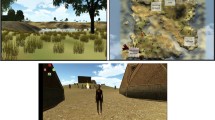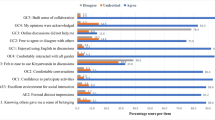Abstract
This study seeks to investigate the effect of pre-service foreign language teachers’ interactions on their continuing professional development (CPD), using a theoretical instructional design framework consisted of the three presence indicators of a Community of Inquiry (CoI) model and the Jigsaw teaching technique. The investigation was performed through a case study with thirty-five (n = 35) teachers who participated voluntarily in three consecutive tasks, by blending Sloodle as a free plug-in via the three-dimensional (3D) multi-user virtual world Open Simulator (Open Sim), with the purpose of creating virtual learning environments. A mixed-method research was conducted to be measured pre-service teachers’ engagement, using a validated CoI model questionnaire proposed by Arbaugh et al. (2008) for collecting the quantitative data, and secondly their opinions for participation, achievements, abilities and difficulties, when studying collaboratively with their peers for gathering the qualitative data, after finishing several learning tasks. The study findings indicate that collaborative practice-based tasks in synchronous communication modes, such as group work, team effort, instructor’s or peer feedback and consolidated learning material in a 3D multi-user virtual environment have enhanced the learning experience for more meaningful outcomes. The highest mean scores were adequately addressed to the teaching and social presences, indicating that pre-service teachers were enough satisfied due to the easy expression of proposals and the sense of freedom for exchanging ideas/opinions with their colleagues. This study contributes on the fundamental issues of cooperation, socialization, retention and attendance rates rising among teachers’ interactions with the respect to empower not only their CPD, but also their management and learning responsibilities, based on the affordances that a 3D technology-enhanced environment can provide.



Similar content being viewed by others
References
Akyol, Z., & Garrison, D. R. (2008). The development of a community of inquiry over time in an online course: Understanding the progression and integration of social, cognitive and teaching presence. Journal of Asynchronous Learning Networks, 12(2–3), 3–22.
Arbaugh, B. (2004). Learning to learn online: a study of perceptual changes between multiple online course experiences. The Internet and Higher. Education, 7(2), 169–182.
Berns, A., Gonzalez-Pardo, A., and Camacho, D. (2013). Game-like language learning in 3-D virtual environments. Computers and Education, 60(1), 210–220.
Borg, S. (2003). Teacher cognition in language teaching: A review of research on what language teachers think, know, believe, and do. Language Teaching, 36(2), 81–109.
Buraphadeja, V., & Dawson, K. (2008). Content analysis in computer-mediated communications: analyzing models for assessing critical thinking through the lens of social constructivism. American Journal of Distance Education, 22(3), 130–145.
Callaghan, M. J., McCusker, K. A., Lopez Losada, J., Harkin, J. G. and Wilson, S. (2009). Teaching engineering education using virtual worlds and virtual learning environments. International Conference on Advances in Computing, Control, and Telecommunication Technologies (pp. 295–299). New Delhi.
Chen, Y. H., Jang, S. J., & Chen, P. J. (2015). Using wikis and collaborative learning for science teachers’ professional development. Journal of Computer Assisted Learning. doi:10.1111/jcal.12095.
Cho, Y., Yim, S. & Paik, S. (2015). Physical and social presence in 3D virtual role-play for pre-service teachers. The Internet and Higher Education, 25(1), 70–77.
Correa, D. M. (2001). New technologies in teaching and learning English. In M. B. Fortkamp, & R. P. Xavier (Eds.), EFL Teaching and learning in Brazil: theory and practice (pp. 211–222). Florianópolis: Insular.
Creswell, J. W., Plano Clark, V. L., Gutmann, M. L., & Hanson, W. E. (2003). Advanced mixed methods research designs. In A. Tashakkori, & C. Teddlie (Eds.), Handbook of mixed methods in social and behavioral research (pp. 209–240). Thousand Oaks, CA: Sage.
Dennen, V., Darabi, A. & Smith, L. (2007). Instructor–Learner Interaction in Online Courses: The relative perceived importance of particular instructor actions on performance and satisfaction. Distance Education, 28(1), 65–79.
Dickey, M. D. (2005). Brave (new) interactive worlds: A review of the design affordances and constraints of two 3D virtual worlds as interactive learning environments. Interactive Learning Environments, 13(1–2), 121–137.
Dillenbourg, P., & Hong, F. (2008). The mechanism of CSCL macro scripts. International Journal of Computer-Supported Collaborative Learning, 3(1), 5–23.
Gamage, V., Tretiakov, A., & Crump B. (2011). Teacher perceptions of learning affordances of multiuser virtual environments. Computers & Education, 57, 2406–2413.
Garrison, D. R. (2000). Theoretical challenges for distance education in the 21st century: A shift from structural to transactional issues. The International Review of Research in Open and Distance Learning, 1(1).
Garrison, D. R., Anderson, T., & Archer, W. (2000). Critical inquiry in a text-based environment: Computer conferencing in higher education model. The Internet and Higher Education, 2(2–3), 87–105.
Garrison, D. R., Anderson, T., & Archer, W. (2010). The first decade of the community of inquiry framework: A retrospective. The Internet and Higher Education, 13(1–2), 5–9.
Garrison, D. R., & Arbaugh, J. B. (2007). Researching the community of inquiry framework: Review, issues, and future directions. The Internet and Higher Education, 10(3), 157–172.
Garrison, D. R., & Cleveland-Innes, M. (2005). Facilitating cognitive presence in online learning: Interaction is not enough. American Journal of Distance Education, 19(3), 133–148.
Garrison, D. R., Cleveland-Innes, M., & Fung, T. S. (2010). Exploring causal relationships among teaching, cognitive and social presence: Student perceptions of the community of inquiry framework. The Internet and Higher Education, 13(1–2), 31–36.
Gorsky, P., & Blau, I. (2009). Online teaching effectiveness: A tale of two instructors. International Review of Research on Open and Distance Learning, 10(3), 1–27.
Gregory, S., & Masters, Y. (2012). Real thinking with virtual hats: A role-playing activity for pre-service teachers in Second Life. Australasian Journal of Educational Technology, 28(3), 420–440.
Hinze, U., Bischoff, M. & Blakowski, G. (2002). Jigsaw method in the context of CSCL. In: Proceedings of World Conference on Educational Multimedia, Hypermedia and Telecommunications (Vol. 1), 789–794.
Huang, K., Lubin, I. A. & Ge, X. (2011). Situated learning in an educational technology course for pre-service teachers. Teaching and Teacher Education, 27(8), 1200–1212.
Jick, T. D. (1979). Mixing qualitative and quantitative methods: triangulation in action. Administrative Science Quarterly, 24, 602–611.
Joo, Y., Yon Kim, K., & Kyung Kim, E. (2011). Online university students’ satisfaction and persistence: Examining perceived level of presence, usefulness and ease of use as predictors in a structural model. Computers & Education, 57, 1654–1664.
Kallonis, P. & Sampson, D. (2011). A 3D Virtual Classroom Simulation for supporting School Teachers’ Training based on Synectics - ‘making the strange familiar. In Proceedings of the 11th IEEE International Conference on Advanced Learning Technologies (ICALT 2011). Athens, Georgia, USA, IEEE Computer Society.
Kanuka, H., & Anderson, T. (1998). Online social interchange, discord, and knowledge construction. The Journal of Distance Education, 13(1), 57–74.
Kling, R., & Courtright, C. (2003). Group behavior and learning in electronic forums: A sociotechnical approach. The Information Society, 19(3), 221–235.
Kemp, J., Livingstone, D. & Bloomfield, P. (2009). SLOODLE: Connecting VLE tools with emergent teaching Practice in Second Life. British Journal of Educational Technology, 40(3), 551–555.
Konstantinidis, A., Tsiatsos, Th., Terzidou, Th. & Pomportsis, A. (2010). Fostering collaborative learning in second life: metaphors and affordances. Computers & Education, 55(2), 603–615.
Kordaki, M., Siempos, H., & Daradoumis, T. (2009). Collaborative learning design within open source e-learning systems: lessons learned from an empirical study. In G. Magoulas (Ed.), E-Infrastructures and technologies for lifelong learning: Next generation environments (pp. 212–232). IDEA-Group Publishing.
Liu, T. C. (2005). Web-based Cognitive Apprenticeship Model for Improving Pre-service Teachers’ Performances and Attitudes towards Instructional Planning: Design and Field Experiment. Educational Technology & Society, 8(2), 136–149.
Martzoukou, K. (2013). Empowering information literacy and continuing professional development of librarians: new paradigms for learning and practice. Worldwide Commonalities and Challenges in Information Literacy Research (pp. 647–654). Springer International Publishing.
Macdonald, J., & Poniatowska, B. (2011). Designing the professional development of staff for teaching online: an OU (UK) case study. Distance Education, 32, 119–134.
McKerlich, R., Riis, M., Anderson, T., & Eastman, B. (2011). Student perceptions of teaching presence, social presence, and cognitive presence in a virtual world. MERLOT Journal of Online Learning and Teaching, 7(3), 324–336.
Pellas, N. (2014a). Open source virtual worlds for e-learning. In M. Khosrow-Pour (Ed.), Encyclopedia of Information Science and Technology (pp. 7538–7547). Hershey, PA: IGI Global.
Pellas, N. (2014b). A cybernetic framework to articulate the organizational complexity of users’ interactions with the Jigsaw technique in an Open Sim standalone server. International Journal of Innovation and Learning, 17(3), 326–358.
Pellas, N. (2014c). The influence of computer self-efficacy, metacognitive self-regulation and self-esteem on student engagement in online learning programs: Evidence from the virtual world of Second Life. Computers in Human Behavior, 35(1), 157–170.
Pellas, N. (2015). Bolstering the quality and integrity of online collaborative courses at university-level with the conjunction of Sloodle and Open Simulator. Education and Information Technologies. doi:10.1007/s10639-014-9365-1.
Pellas, N., & Kazanidis, I. (2014a). The impact of computer self-efficacy, situational interest and academic self-concept in virtual communities of inquiry during the distance learning procedures through Second Life. World Wide Web Journal, 17(4), 695–722.
Pellas, N., & Kazanidis, I. (2014b). Online and hybrid university-level courses with the utilization of Second Life: Investigating the factors that predict student choice in Second Life supported online and hybrid university-level courses. Computers in Human Behavior, 40(2), 31–43.
Rayner, C., & Fluck, A. (2014). Pre-service teachers’ perceptions of simSchool as preparation for inclusive education: a pilot study. Asia-Pacific Journal of Teacher Education, 42(3), 212–227.
Rovai, A. P. (2002). Sense of community, perceived cognitive learning, and persistence in asynchronous learning networks. The Internet and Higher Education, 5(4), 319–33.
Ryoo, J., Techatassanasoontorn, A., Lee, D. & Lothian, J. (2011). Game-based Infosec education using Open Sim. In Proceedings of the 15th Colloquium for Information systems security Education. Ohio.
Seezink, A., & Poell, R. (2010). Continuing professional development needs of teachers in schools for competence-based vocational education. Journal of European Industrial Training, 34(5), 455–474.
Sing, C. C., & Khine, M. S. (2006). An analysis of interaction and participation patterns in online community. Educational Technology & Society, 9(1), 250–261.
Singhal, M. (1997). The internet and foreign language education: Benefits and challenges. The Internet TESL. Journal, III (6). Wang, F. & Burton, J. (2013). Second Life in education: A review of publications from its launch to 2011. British Journal of Educational Technology, 44(3), 357–371.
Shea, P., & Bidjerano, T. (2009). Cognitive presence and online learner engagement: a cluster analysis of the community of inquiry framework. Journal of Computing in Higher Education, 29(3), 199–217.
Shea, P., & Bidjerano, T. (2010). Learning presence: Towards a theory of self-efficacy, self-regulation, and the development of a communities of inquiry in online and blended learning environments. Computers & Education, 55(4), 1721–1731.
Swan, K., Garrison, D. R. & Richardson, J. (2009). A constructivist approach to online learning: The community of inquiry framework. In C. R. Payne (Ed.), Information technology and constructivism in higher education: Progressive learning frameworks (pp. 43–57). Hershey, PA: IGI Global.
Traphagan, T., Chiang, Y., Chang, M., Wattanawaha, B., Lee, H., Mayrath, M., Woo, J., Yoon, H., Jee, M. & Resta, P. (2010). Cognitive, social and teaching presence in a virtual world and a text chat. Computers & Education 55(2), 923–936.
Wang, X., Kim, B., Lee, J. W. Y., & Kim, M. S. (2014). Encouraging and being encouraged: Development of an epistemic community and teacher professional growth in a Singapore classroom. Teaching and Teacher Education, 44, 12–24.
Author information
Authors and Affiliations
Corresponding author
Ethics declarations
Funding
This study was not funded by anyone.
Conflict of interest
The authors declare that they have no conflict of interest.
Rights and permissions
About this article
Cite this article
Pellas, N., Boumpa, A. Blending the CoI model with Jigsaw technique for pre-service foreign language teachers’ continuing professional development using Open Sim and Sloodle. Educ Inf Technol 22, 939–964 (2017). https://doi.org/10.1007/s10639-016-9465-1
Published:
Issue Date:
DOI: https://doi.org/10.1007/s10639-016-9465-1




